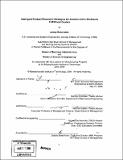Intelligent product placement strategies for Amazon.com's worldwide fulfillment centers
Author(s)
Rubenstein, Linsey (Linsey Jill)
DownloadFull printable version (8.154Mb)
Other Contributors
Leaders for Manufacturing Program.
Advisor
Stanley Gershwin and Jeremie Gallien.
Terms of use
Metadata
Show full item recordAbstract
Online retail has radically changed traditional supply chain operations by providing a direct-to-consumer model that eliminates the need for traditional brick-and-mortar retail stores. With this new order, retailers have had to design warehouse solutions that fit the changing operational requirements of online retail. Over the last several years, Amazon.com has become a market leader, capturing almost 8% of all online retail sales in 2005. As Amazon grows in size and scope it is faced with unique challenges in warehouse system design and strategy. A significant portion of Amazon's total fulfillment cost is in the "picking" process which is where associates pick items to fulfill customer orders. Picking costs are directly influenced by the upstream stowing process which determines where to physically store Amazon's retail items. Currently, Amazon's fulfillment centers stow inventory according to "profiling" rules which direct inventory to various locations in the warehouse in order to optimize the space utilization of the facility. However, these profiling rules do not account for the impact of the stowing decisions on the cost to pick and replenish products downstream. (cont.) While facility space reaches capacity during peak season, the fulfillment centers are well below their physical space capacity the remainder of the year. Due to the cyclical nature of customer demand at Amazon, the current profiling strategy of optimizing space utilization may be sub-optimal during the low demand periods when space capacity is not a constraint. This thesis will test this hypothesis by exploring alternative product placement strategies for Amazon's fulfillment centers.
Description
Thesis (M.B.A.)--Massachusetts Institute of Technology, Sloan School of Management; and, (S.M.)--Massachusetts Institute of Technology, Engineering Systems Division; in conjunction with the Leaders for Manufacturing Program at MIT, 2006. Page 66 blank. Includes bibliographical references.
Date issued
2006Department
Leaders for Manufacturing Program at MIT; Massachusetts Institute of Technology. Engineering Systems Division; Sloan School of ManagementPublisher
Massachusetts Institute of Technology
Keywords
Sloan School of Management., Engineering Systems Division., Leaders for Manufacturing Program.